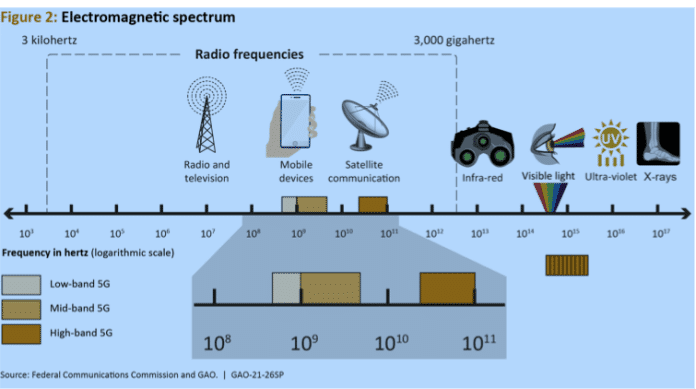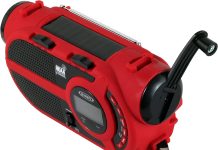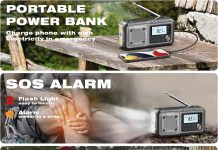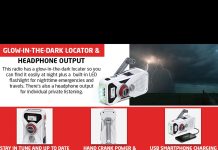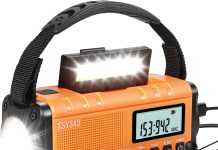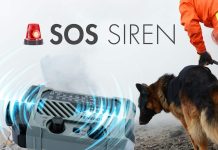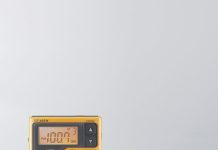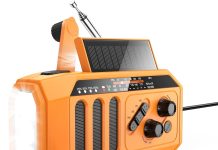In this article, we explore the capabilities of most emergency radios when it comes to receiving various frequencies. Have you ever wondered just how many different frequencies these radios can pick up? Whether you’re a seasoned emergency responder or a curious individual interested in emergency preparedness, understanding the range of frequencies that emergency radios can handle is crucial in ensuring effective communication during critical situations. So, let’s dive into the world of emergency radios and discover the answer to this intriguing question.
Review contents
Types of Emergency Radios
When it comes to emergency radios, there are two main types: analog radios and digital radios. Each type has its own unique features and benefits, so let’s explore them further and see which one is right for you.
Analog Radios
Analog radios have been around for quite some time and are known for their simplicity and reliability. They operate using a continuous wave signal, which means the signal is constantly being transmitted. Analog radios are great for basic communication needs and can receive a wide range of frequencies.
Digital Radios
On the other hand, digital radios are more advanced and offer enhanced features compared to analog radios. They use digital signals, which allows for clearer and more secure communication. Digital radios also have the ability to decode and display text messages, weather alerts, and other data. Additionally, they can receive both analog and digital signals, making them versatile in emergency situations.
Emergency Radio Frequencies
Emergency radios are designed to receive specific frequencies that are commonly used during emergencies. These frequencies can vary depending on the type of emergency and the location. Let’s take a look at some of the most common emergency radio frequencies.
VHF Frequencies
VHF (Very High Frequency) frequencies are commonly used for various purposes, including emergency communication. They operate in the range of 30 MHz to 300 MHz. VHF frequencies are known for their ability to transmit signals over relatively long distances, making them ideal for emergency situations.
UHF Frequencies
UHF (Ultra High Frequency) frequencies are another commonly used frequency range for emergency communication. They operate in the range of 300 MHz to 3 GHz. UHF frequencies are known for their ability to penetrate obstacles such as buildings and vegetation, making them suitable for urban areas.
HF Frequencies
HF (High Frequency) frequencies are used for long-distance communication, especially in cases where other frequencies might be blocked or unreliable. They operate in the range of 3 MHz to 30 MHz. HF frequencies can bounce off the Earth’s ionosphere, allowing for long-range communication during emergencies.
FM Frequencies
FM (Frequency Modulation) frequencies are commonly used for broadcasting and communication. They operate in the range of 88 MHz to 108 MHz. FM frequencies are known for their high sound quality and are often used by public safety agencies and weather stations to broadcast emergency information.
AM Frequencies
AM (Amplitude Modulation) frequencies are another commonly used frequency range for emergency communication. They operate in the range of 525 kHz to 1705 kHz. AM frequencies are known for their ability to travel long distances and are often used for broadcasting emergency alerts and public announcements.
VHF Frequencies
VHF frequencies can be further divided into two bands: VHF High Band and VHF Low Band. Each band has its own unique characteristics and applications.
VHF High Band
The VHF High Band operates in the range of 136 MHz to 174 MHz. This band is commonly used by emergency services, such as police and fire departments, as well as by commercial radio stations. VHF High Band frequencies are known for their ability to transmit signals over long distances and are suitable for outdoor communication.
VHF Low Band
The VHF Low Band operates in the range of 30 MHz to 50 MHz. This band is commonly used by government agencies, such as the military and federal agencies. VHF Low Band frequencies are known for their ability to penetrate obstacles and are suitable for communication in rural and wooded areas.
UHF Frequencies
UHF frequencies can be further divided into three bands: UHF-T Band, UHF-5 Band, and UHF-7 Band. Each band has its own specific range and applications.
UHF-T Band
The UHF-T Band operates in the range of 450 MHz to 470 MHz. This band is commonly used by public safety agencies, such as police and fire departments, for communication within a localized area. UHF-T Band frequencies are known for their ability to provide clear and reliable communication in urban environments.
UHF-5 Band
The UHF-5 Band operates in the range of 470 MHz to 512 MHz. This band is commonly used by wireless microphones, baby monitors, and other wireless audio devices. UHF-5 Band frequencies are known for their ability to provide interference-free communication and are suitable for use in crowded areas.
UHF-7 Band
The UHF-7 Band operates in the range of 764 MHz to 806 MHz. This band is commonly used by public safety agencies and government organizations for communication. UHF-7 Band frequencies are known for their ability to provide reliable communication over long distances and are suitable for both outdoor and indoor use.
HF Frequencies
HF frequencies can be divided into three bands: HF Low Band, HF High Band, and HF Air Band. Each band has its own specific range and applications.
HF Low Band
The HF Low Band operates in the range of 3 MHz to 10 MHz. This band is commonly used for long-distance communication, especially in remote areas where other frequencies may not be accessible. HF Low Band frequencies are known for their ability to bounce off the Earth’s ionosphere, allowing for long-range communication.
HF High Band
The HF High Band operates in the range of 10 MHz to 30 MHz. This band is commonly used by amateur radio operators, as well as for maritime and aeronautical communication. HF High Band frequencies are known for their ability to provide reliable communication even in challenging conditions, such as during storms or natural disasters.
HF Air Band
The HF Air Band operates in the range of 2.5 MHz to 25 MHz. This band is specifically allocated for aeronautical communication, including air traffic control and pilot-to-pilot communication. HF Air Band frequencies are known for their ability to provide long-range communication for aviation purposes.
FM Frequencies
FM frequencies are commonly used for broadcasting and communication, including emergency communication. There are two main types of FM frequencies: Public Safety FM and Weather FM.
Public Safety FM
Public Safety FM frequencies are used by public safety agencies, such as police and fire departments, for critical communication during emergencies. These frequencies are typically in the VHF and UHF bands and are used for local communication within a specific area. Public Safety FM frequencies are known for their clarity and reliability in emergency situations.
Weather FM
Weather FM frequencies are used by weather stations to broadcast weather updates and emergency alerts. These frequencies are typically in the VHF band and can be received by the general public using a weather radio or a compatible device. Weather FM frequencies are crucial for staying informed about severe weather conditions and potential hazards.
AM Frequencies
AM frequencies are commonly used for broadcasting emergency alerts, public announcements, and general communication. There are three main types of AM frequencies: Medium Wave (MW) AM, Shortwave (SW) AM, and Citizens Band (CB) AM.
Medium Wave (MW) AM
Medium Wave (MW) AM frequencies are commonly used for local and regional broadcasting. These frequencies are in the range of 525 kHz to 1705 kHz and can provide reliable communication within a limited area. MW AM frequencies are known for their ability to penetrate obstacles, such as buildings and trees, making them suitable for urban areas.
Shortwave (SW) AM
Shortwave (SW) AM frequencies are used for long-distance communication, especially in cases where other frequencies may not be available. These frequencies are in the range of 2 MHz to 30 MHz and can bounce off the Earth’s ionosphere, allowing for communication over large distances. SW AM frequencies are widely used by international broadcasters and amateur radio operators.
Citizens Band (CB) AM
Citizens Band (CB) AM frequencies are used for short-range communication, typically within a few miles. These frequencies are in the range of 26.965 MHz to 27.405 MHz and are widely used by truckers, off-roaders, and other individuals for general communication purposes. CB AM frequencies require a specific radio designed for this band.
Other Frequency Bands
In addition to the common emergency frequencies mentioned above, there are several other frequency bands that are essential for emergency communication.
NOAA Weather Radio
NOAA (National Oceanic and Atmospheric Administration) Weather Radio frequencies are dedicated to broadcasting weather updates, watches, warnings, and other emergency information. These frequencies are typically in the VHF band and can be received using a compatible weather radio or a scanner.
Marine VHF Radio
Marine VHF frequencies are used for communication between boats, ships, and shore stations. These frequencies are in the VHF band and are crucial for maritime safety and emergency coordination. Marine VHF radios are designed specifically for use on water and are required on most boats.
Aviation Frequencies
Aviation frequencies are used for communication between aircraft and air traffic control. These frequencies include both VHF and HF bands and are allocated for specific purposes, such as navigation, air traffic coordination, and emergency communication. Aviation radios are designed to meet the stringent requirements of the aviation industry.
Frequency Range of Emergency Radios
Emergency radios come in different configurations, and their frequency range can vary depending on the model and features. Let’s take a closer look at the different frequency ranges available.
Single Band Radios
Single band radios are designed to receive signals within a specific frequency range. These radios are often dedicated to a particular band, such as VHF, UHF, or HF. While single band radios can provide reliable communication within their designated range, they may not be as versatile as other types of radios.
Dual Band Radios
Dual band radios can receive signals from two different frequency ranges. For example, a dual band radio may be able to receive both VHF and UHF frequencies. These radios offer increased flexibility and compatibility with different communication systems. Dual band radios are commonly used by emergency services and amateur radio operators.
Multi-Band Radios
Multi-band radios are designed to receive signals from multiple frequency ranges. These radios can cover a wide spectrum of frequencies, including VHF, UHF, HF, and more. They are often used by professionals, such as first responders and emergency management personnel, who need to communicate on various frequencies in different situations.
Factors Affecting Reception of Frequencies
Several factors can affect the reception of frequencies on emergency radios. Understanding these factors can help improve the effectiveness of communication during emergencies.
Radio Technology
The technology used in emergency radios plays a significant role in reception quality. Modern digital radios often offer better clarity and noise reduction compared to analog radios. Additionally, advanced features like automatic frequency scanning and signal filtering can enhance reception performance.
Antenna Type
The type and quality of the antenna used on an emergency radio can greatly influence reception. A longer or more efficient antenna can improve signal strength and range. External antennas or antennas designed for specific frequencies can also help overcome reception challenges in different environments.
Environmental Conditions
The environment in which an emergency radio is used can impact reception. Physical obstacles like buildings or terrain can block or weaken signals, especially in urban or mountainous areas. Additionally, weather conditions like storms or heavy precipitation can cause interference and reduce signal quality.
Interferences
Interferences from other electronic devices or radio signals can affect reception on emergency radios. Nearby power lines, electrical devices, or even nearby radio transmitters can cause unwanted noise or signal distortion. Selecting an emergency radio with proper filtering capabilities can help mitigate these interferences.
In conclusion, emergency radios are designed to receive a wide range of frequencies that are crucial for communication during emergencies. Understanding the different types of emergency radios, frequency bands, and factors affecting reception can help you choose the right radio for your needs. Whether you opt for an analog or digital radio, it’s essential to ensure that it covers the necessary frequencies and is equipped with the features you require. Remember, staying informed and connected during emergencies can make all the difference in ensuring your safety and well-being.

